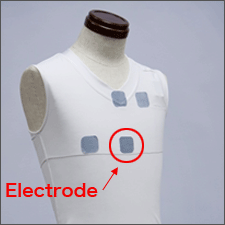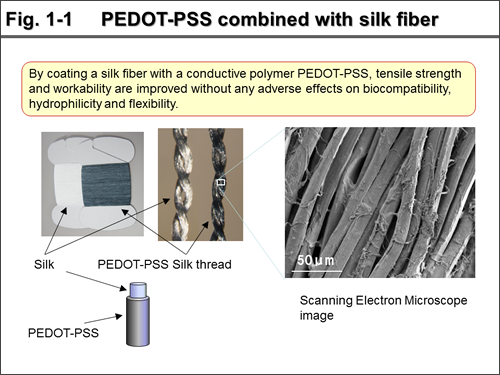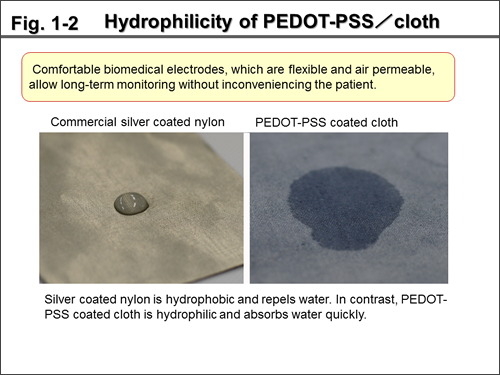Electrocardiography is achieved simply by wearing a piece of clothing that has textile electrodes combined with conductive polymer
- By coating fiber with conductive polymers, biomedical signals can be recorded without patient discomfort via a wearable electrode -

NTT Basic Research Laboratories(NTT-BRL) has developed a conductive fiber by coating the surface of silk or synthetic fiber with conductive polymer (PEDOT-PSS*1) and has used it to fabricate wearable electrodes*2 with which to obtain biomedical recordings.
Conventional biomedical electrodes use an electrolyte paste or gel*3, which results in excessive wetting of the skin surface and occasionally causes skin irritation or contact dermatitis. The new bioelectrode made of conductive fiber without any electrolyte paste is flexible, biocompatible, and hydrophilic and so allows stable recording equivalent to that of a conventional electrode.
Experiments on 10 able-bodied human volunteers wearing undershirts equipped with the electrode revealed successful long-term recording of the heartbeat and electrocardiograms*4.
This result shows that the heartbeat and electrocardiograms can be monitored continuously simply by wearing the electrode shirts. We can expect the electrode to find various applications in sports, health enhancement, and the support of medical diagnosis, as well as scientific research.
=> Press Release
=> Molecular and Bio Science Research Group
1.Background
In today’s aging society, the continuous monitoring of the heartbeat and electrocardiograms is expected to reduce the risk of a heart attack (sudden death) through the early detection and early treatment of any cardiac malfunction. Monitoring is also effective in preventing the physical overload caused by improper exercise and the accumulation of mental stress. However, the conventional biomedical electrode with electrolyte paste is unsuitable for continuous monitoring in daily life, because it is uncomfortable when stuck to the skin. Moreover, excessive wetting of the skin surface occasionally causes skin irritation or contact dermatitis. Recently, textile electrodes made of silver-coated fiber have been widely used for heartbeat monitoring especially in the sports field. However, for medical quality electrocardiogram monitoring, further improvement is required to reduce the noise level.
The conductive polymer PEDOT-PSS is a promising material for use as a biomedical electrode because of its hydrophilicity and biocompatibility. However, it is fragile when wet, and its water resistance and workability must be improved if its applications are to expand.
Scientists at NTT have used PEDOT-PSS to modify the surface of a microelectrode array (MEA)*5. The excellent biocompatibility and improved electrical property of this array was confirmed in 2004 by culturing nerve cells on it and embedding it in animals. Recently, NTT has been trying to fabricate a flexible biomedical electrode by combining PEDOT-PSS and silk fiber.
2.Achievements
The flexible biomedical electrode is produced by coating silk fiber with PEDOT-PSS, and the resulting material can be used as both thread and textile (Fig. 1-1, Fig.1-2). The coating conditions have been devised in such a way that the tensile strength and workability have been improved without any detrimental effects on biocompatibility, hydrophilicity and flexibility. A surface electrode without any electrolyte paste was used to measure an electrocardiogram of a rat with stability equivalent to that of a conventional medical electrode (Fig. 2). A wearable electrode has been fabricated by mounting a conductive textile on a shirt, and simply wearing this shirt enables the heartbeat and electrocardiograms to be monitored (Fig. 3). Comfortable biomedical electrodes, which are both flexible and air permeable, make long-term monitoring possible without inconveniencing the patient.
The safety of the wearable electrodes has been evaluated with 10 able-bodied human volunteers. The successful long-term recording of the heartbeat and electrocardiograms was confirmed without any skin irritation or contact dermatitis.
3.Future plan
In addition, NTT will investigate the safety and effectiveness of the wearable electrode made of PEDOT-PSS combined with fibers as regards the long-term monitoring of the heartbeat and electrocardiograms by undertaking a substantive experiment on around 100 people. We will be considering applications in the medical field such as home medical care and remote medicine through collaboration with, for example, schools of medicine. We will also consider its application in various contexts; e.g. supporting medical examinations by reducing patient discomfort, and developing comfortable sportswear to promote health (Fig. 4).
*1 ... PEDOT-PSS
PEDOT-PSS is a typical conductive polymer that is widely used as a transparent electrode and for the antistatic coating of plastics due to its high conductivity and chemical stability in various environments. PEDOT-PSS products are commercially available from Heraeus (Germany).
*2 ... Wearable electrodes
These electrodes are used for detecting biomedical signals or for the electric stimulation of living organisms and are simply worn by the subject.
*3 ... Electrolyte paste or gel
The conventional electrocardiogram recording system requires an electrolyte paste or gel to improve the interface between the metal electrode and the skin surface.
*4 ... Evaluation of material safety of PEDOT-PSS
Experiments on animals and human volunteers were performed with the permission of the ethical committee of NTT Basic Research Laboratories. The human subjects wore the electrode undershirts for more than 24 hours and made subjective notes of their symptoms. After the recordings had finished, the skin condition was examined for reddening, edema or surface deterioration.
*5 ... Microelectrode array (MEA)
An MEA is a device that contains multiple electrodes for detecting neuronal signals or for the electric stimulation of neurons.















